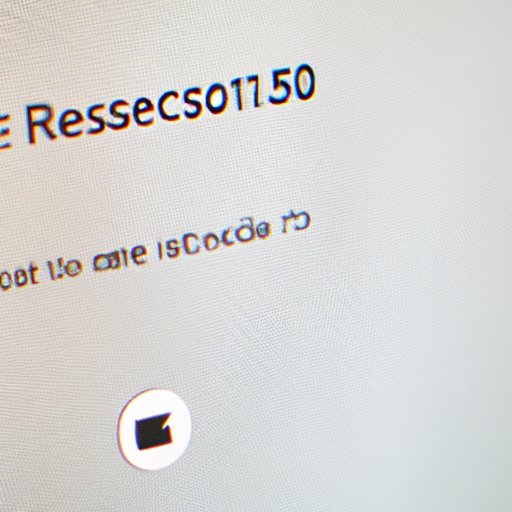I. Introduction
As a MacBook owner, it’s important to know how to factory reset your device. A factory reset allows you to erase all data and settings stored on your MacBook, including any malware or viruses that may have infected your device. This is especially useful when you’re planning to sell or hand over your device to someone else. In this article, we will explore all the necessary steps to factory reset a MacBook, restoring it to its original factory settings.
II. Understanding Factory Reset
By definition, a factory reset, also known as a hard reset or master reset, is a process that restores your MacBook to its original factory settings. This includes erasing all applications, data, and any personal settings. Unlike a soft reset that only reboots your device, a factory reset completely wipes out all data and files, making it an effective solution to fixing issues with your MacBook.
III. Step-By-Step Guide: How to Factory Reset Your MacBook in Less Than 10 Minutes
A factory reset is a straightforward process that can typically be accomplished in less than 10 minutes. However, before starting the process, it’s essential to back up all important data stored on your device. Once you’ve secured your data, follow the steps below to factory reset your MacBook.
Brief Overview of the Steps Involved:
1. Restart your MacBook in Recovery Mode.
2. Access Disk Utility from the recovery menu.
3. Erase the hard drive by selecting the ‘Erase’ option.
4. Install a new copy of the MacOS operating system.
Detailed instructions on how to factory reset your MacBook:
Step 1: Restart your MacBook in Recovery Mode
The first step toward factory resetting your MacBook is to shut it down completely. Once your MacBook is powered off, hold down the ‘Command + R’ keys on your keyboard as you power it back on. Continue holding these keys until the Apple logo appears, and your MacBook boots into Recovery Mode.
Step 2: Access Disk Utility from the recovery menu
Next, select the ‘Disk Utility’ option from the recovery menu. This will allow you to view all disks and drives connected to your MacBook.
Step 3: Erase the hard drive by selecting the ‘Erase’ option
Select the hard drive you would like to erase from the list of available options on the left side of your screen. Once selected, click the ‘Erase’ button located at the top of the screen. Follow the prompts to erase your hard drive.
Step 4: Install a new copy of the MacOS operating system
Once your hard drive is erased, select the ‘Reinstall MacOS’ option from the recovery window. Follow the prompts to download and install a new copy of the MacOS operating system. Once the installation process is complete, your device will be restored to its original factory settings.

IV. The Ultimate Guide to Restoring Your MacBook to Its Original Factory Settings
Restoring your MacBook to its original factory settings is a process that can be achieved in several different ways, including reinstalling the MacOS operating system or using Time Machine to restore your device to a previous backup. Here’s what you need to know.
What restoring your MacBook to its original factory settings mean:
Restoring your MacBook to its original factory settings means wiping out all data, applications, and settings on your device, returning it to the same state it was when you first purchased it.
Why it might be necessary:
There are several reasons why restoring your MacBook to its original factory settings is a necessary action. This includes selling or handing over your MacBook to someone else, resolving software issues that cannot be fixed by other methods, or simply wanting to start fresh with a clean slate.
How to restore your MacBook:
Restoring your MacBook can be done in several ways. One option is to use Time Machine to restore to a previous backup. Alternatively, you can reinstall the MacOS operating system, either by using an installation disc or downloading it from the internet.
V. Troubleshooting 101: Learn How to Factory Reset Your MacBook
There are several troubleshooting scenarios that may require you to factory reset your MacBook. These include system crashes, malware or virus infections, slow performance, or unresponsive software. Here’s what you need to know.
Common troubleshooting scenarios that require a factory reset:
Common scenarios that may require a factory reset include a malfunctioning MacOS operating system, frequent crashes or freezes, or severe malware or virus infections that cannot be removed by other methods.
How to troubleshoot common issues:
To troubleshoot common issues, begin by backing up all important data and files. Next, try updating your software to the latest version, running a malware or antivirus scan, or restoring to a previous backup using Time Machine. If these methods fail, a factory reset may be the best course of action.
How to factory reset your MacBook when troubleshooting:
To factory reset your MacBook when troubleshooting, follow the same steps outlined in section III.
VI. Simple Guide to Erase All Data from Your MacBook and Start Fresh
If you’re looking to erase all data and start fresh with a clean MacBook, there are several ways to do so. One common method is to use the built-in Disk Utility app. Here’s how.
Explanation of how to erase all data from your MacBook:
To erase all data from your MacBook, you will need to use the Disk Utility app. From there, you can select the hard drive you want to erase and follow the prompts to erase your device.
Understanding the importance of backing up your data:
Before erasing all data from your MacBook, it’s important to back up all important data and files. This will ensure that you can restore your data to a new device and prevent any data loss.
Detailed instructions on how to erase all data from your MacBook:
To erase all data from your MacBook using Disk Utility, follow these steps:
1. Power off your MacBook
2. Hold down the ‘Command + R’ keys and power it back on
3. Select Disk Utility from the recovery menu
4. Select the hard drive you wish to erase
5. Click the ‘Erase’ button and follow the prompts to erase your device completely.
VII. From Slow to New: How to Factory Reset a MacBook for Better Performance
If your MacBook is running slowly, a factory reset may be the perfect solution to improve performance. Here’s what you need to know.
Causes of slow MacBook performance:
Slow MacBook performance can be caused by a variety of factors, including outdated software, insufficient storage, or malware or virus infections.
How a factory reset can help:
A factory reset can help improve MacBook performance, as it removes all unnecessary files and applications, freeing up valuable storage space. Additionally, it removes any malware or virus infections that may be slowing down your device.
How to factory reset your MacBook for better performance:
To factory reset your MacBook for better performance, follow the same steps outlined in section III.
VIII. The Complete Guide to Reset Your MacBook with or Without the Installation Disc
Resetting your MacBook can be done with or without an installation disc. Here’s what you need to know.
Understanding when you need an installation disc to reset your MacBook:
If your MacBook is running on an older version of the MacOS operating system, you may need an installation disc to reset your device. However, if your device is running on a newer MacOS version, you can simply download a new copy of the operating system from the internet.
How to reset your MacBook with the installation disc:
To reset your MacBook with an installation disc, insert the disc into your device, and follow the on-screen prompts to reinstall the MacOS operating system.
How to reset your MacBook without the installation disc:
To reset your MacBook without an installation disc, follow the same steps outlined in section III.
IX. DIY Erase: Learn How to Safely and Efficiently Factory Reset Your MacBook
When done improperly, a factory reset can cause problems for your MacBook. Here are some tips for safely and efficiently factory resetting your device.
Tips on safely and efficiently factory resetting your MacBook:
To factory reset your MacBook safely and efficiently, begin by backing up all important data and files. Next, make sure to follow all prompts carefully and ensure that you’re selecting the correct hard drive to erase. Finally, be patient, as the process may take several minutes.
What to do to ensure a factory reset doesn’t cause problems:
To ensure that a factory reset doesn’t cause problems for your MacBook, remember to back up your data, follow all prompts carefully, and be patient.
X. Conclusion
In this article, we’ve explored all the necessary steps for factory resetting a MacBook, restoring it to its original factory settings, troubleshooting common issues, and improving performance. By following these steps, you can ensure that your MacBook is functioning at peak performance, giving you peace of mind and a clean slate to start over with your device.
